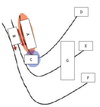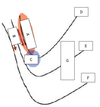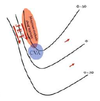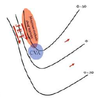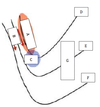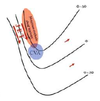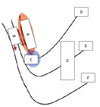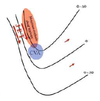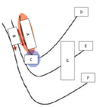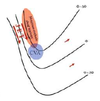chapter 2: Analysis of Mid-latitude Synoptic Scale Systems using QG Height Tendency Equation Flashcards
(108 cards)
The QG Height Tendency Eq. can be expressed as:

the equation is a

partial differential equation describing the local change of the geopotential height (Φ) on an isobaric surface with respect to time
There are three forcing terms on the right-hand side of The QG Height Tendency Eq. From left to right, these forcing terms represent:
- Geostrophic vorticity advection
- Differential thermal advection and
- Differential diabatic heating.
The QG Height Tendency Eq. is applied to
the study of troughs and ridges in the middle troposphere – often at 500 hPa – and not at the surface
The contribution to the local geopotential height tendency exclusively due to geostrophic vorticity advection can be expressed by:

The contribution to the local geopotential height tendency exclusively due to geostrophic vorticity advection can be expressed by:
It depicts the

advection by the geostrophic wind of the geostrophic relative (عg) and planetary vorticity (f)
Cyclonic geostrophic vorticity advection will result in
local decrease in geopotential height with time
Cyclonic geostrophic vorticity advection will result in local decrease in geopotential height with time, because:


Cyclonic geostrophic vorticity advection will result in local decrease in geopotential height with time, because:


Cyclonic geostrophic vorticity advection will result in local decrease in geopotential height with time, because:


Anticyclonic geostrophic vorticity advection will result in
local increase in geopotential height with time
Anticyclonic geostrophic vorticity advection will result in local increase in geopotential height with time, because:


Anticyclonic geostrophic vorticity advection will result in local increase in geopotential height with time, because:


Anticyclonic geostrophic vorticity advection will result in local increase in geopotential height with time, because:


In an idealized trough/ridge scenario where the geostrophic wind is
uniform everywhere
In an idealized trough/ridge scenario where the geostrophic wind is uniform everywhere and thus geostrophic relative vorticity is ………………………. in the base ……………………………
maximized
of each trough
In an idealized trough/ridge scenario where the geostrophic wind is uniform everywhere and thus geostrophic relative vorticity is ………………………….. in the apex …………………………..
minimized
of each ridge
In an idealized trough/ridge scenario where the geostrophic wind is uniform everywhere and thus geostrophic relative vorticity is maximized in the base of each trough
Thus, there is an …………………………… geostrophic vorticity advection to the ……………………………… axis
anticyclonic
west of the trough
In an idealized trough/ridge scenario where the geostrophic wind is uniform everywhere and thus geostrophic relative vorticity is (minimized) in the (apex) of each (ridge).
Thus, there is an ……………………. geostrophic vorticity advection to the…………………………….
(cyclonic)
west of the trough axis
n an idealized trough/ridge scenario where the geostrophic wind is uniform everywhere and thus geostrophic relative vorticity is maximized in the base of each trough
Thus, there is an anticyclonic geostrophic vorticity advection to the west of the trough axis, which is associated with a tendency for height …………
rises
In an idealized trough/ridge scenario (Fig.1), where the geostrophic wind is uniform everywhere and thus geostrophic relative vorticity is (minimized) in the (apex) of each (ridge).
Thus, there is an (cyclonic) geostrophic vorticity advection to the west of the trough axis, which is associated with a tendency for height ………..
falls
A


B


C
























